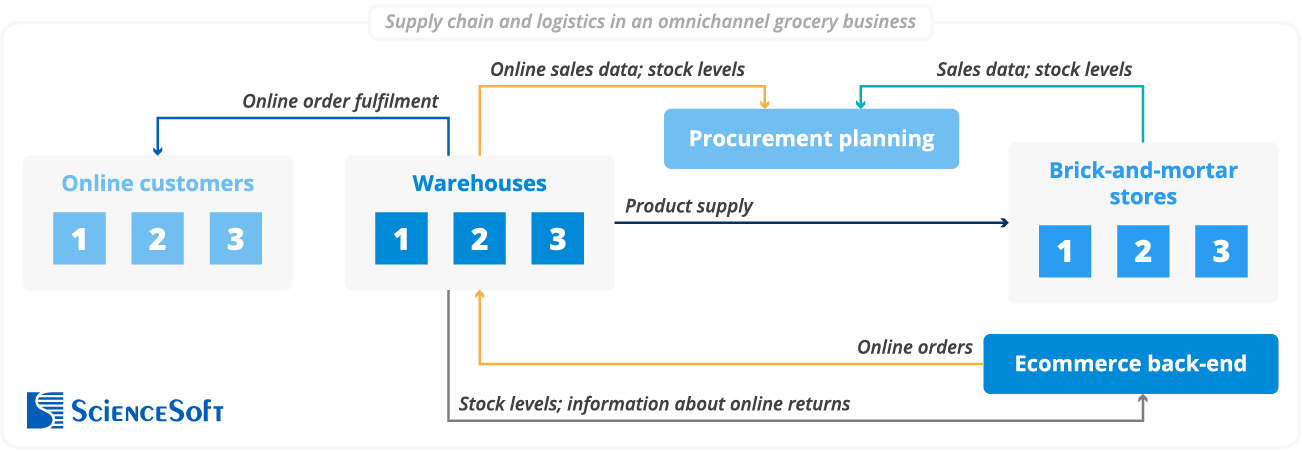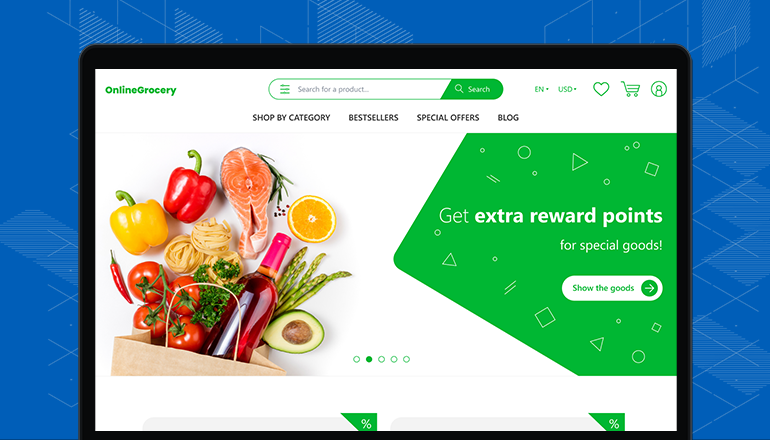Selling Food Online – Business and Technology Guide
ScienceSoft has been providing ecommerce consultancy for 21 years.
Food Ecommerce Market
Selling food online is a good business decision now as digital sales of grocery have been growing steadily through 2021. Back in 2019, the share of online grocery sales in the US remained at the level of 3-4% and accounted for $28.68 billion. However, the rising online service quality and the COVID-19 crisis increased the demand for online groceries by up to 700% in the second quarter of 2020. An overall shift towards online allows us to estimate an online grocery market as increasingly attractive.
Starting a Food Business Online: a Launch Roadmap
1
Market research to find a competitive advantage.
2
Aligning the business concept with a technology solution.
3
Choosing an ecommerce platform upon cost-benefit analysis.
4
Defining an ecommerce solution scope: architecture, customizations, integrations.
5
Planning customer acquisition, conversion and loyalty building.
6
Estimating entry cost, expenditures on technology support, expected ROI.
7
Building converting web design.
Business Models of Online Grocery Business
An online supermarket model
- Highly personalized shopping experience with vast upsell opportunities.
- Same-day delivery to a customer’s door or a pick-up location.
- Money-back freshness guarantee upon delivery.
Technology specifics:
- AI-powered online merchandizing and product recommendations.
- Advanced analytics for procurement.
- Automated order management.
A food delivery marketplace
- A marketplace aggregates vast product selection and benefits from commission fees.
- Vendors manage their supplies and orders on their own.
Technology specifics:
- Vendor self-service tools for product, catalog and order management.
- Guaranteed confidentiality of business data.
- Advanced search capabilities.
An omnichannel model
- Vast customer outreach due to online and offline presence.
- Customer expectations center on experience consistency across channels.
Technology specifics:
- Tech-driven workflow automation.
- Enterprise-wide data management.
- Cross-channel customer management.
- Advanced data analytics.
A subscription model
- Boxed product selections (mostly local production) offered for regular geographically-limited delivery. High focus on building customer loyalty.
Technology specifics:
- Build-a-box functionality.
- An automated delivery schedule.
- Recurring payment.
Ecommerce Software: Key Features for Online Food Business
The feature set for core business workflows
Product and catalog management
- Different product types (simple, configurable, grouped, bundle)
- Layered navigation
- Unlimited number of product attributes
- Automated product-to-category assignment based on product attributes
- Product stock visibility
- Customizable out-of-stock and soon-in-stock displays
- Product tagging and filtering
- Product reviews
- Bulk product import and export
Payment, order management and customer service
- Native payment gateways
- Payment online and upon delivery
- Guest and registered checkout
- Order tracking in the personal account
- Abandoned checkout tracking
- Order summary and editing in the admin panel
- Integration with major shipment carriers
- Return merchandise authorization
- Web APIs to set up data synchronization with other business systems
Analytics and reporting
- Core predefined sales analytics
- Dashboards for report visualization
- Report-building tools
- Batch report export
- PDF report summaries
The feature set for marketing purposes
Customer acquisition
- SEO management
- Support for SEO-focused content types
- Page builder
- Integration with social media
- Referral and affiliate programs
Conversion
- Rule-based online merchandizing
- Pricing and promotion management
- UX and UI design flexibility
- Related products, upsells and cross-sells
- Live search suggestions
- Abandoned cart notification
Retention
- Customer segmentation
- Segment-specific promotion management
- AI-powered experience personalization (personalized promotions, product recommendations)
- Email marketing
- Loyalty management
- Re-ordering
- Experience surveys
Important Integrations: Why and How to Automate the Supply Chain and Logistics

Integrating your ecommerce solution with advanced technologies, you add consistency and visibility into each step of the supply chain and logistics – procurement, manufacturing (in case of own production), storage and shelf life management, order fulfillment and delivery – and significantly reduce the manual effort to manage the processes.
Warehouse automation
Technologies to integrate:
- Industrial IoT and RFID
- Robotics for order picking
- Barcode inventory system
Business gains:
- Automated asset tracking and reporting save up to an employee’s 18 hours of working time per month.
- No probability of human error.
- Quick order picking supports same-day delivery.
- Timely detection of stale stock and no stock-outs.
Order management
Technologies to integrate:
- Automated Order Management System (OMS)
- ERP system with an OMS module
Business gains:
- Saved time and accuracy in order distribution.
- Effective handling of various fulfillment scenarios – back-orders and order-online-pickup-in-store.
- New nodes (warehouses) fit into the supply chain smoothly.
- A custom order flow.
Procurement planning
Technologies to integrate:
- Data analytics
- ERP system with a procurement planning module
Business gains:
- No manual effort to aggregate sales data from different channels.
- Real-time inventory visibility.
- Demand patterns are tracked allowing for flexible procurement prediction.
- Improved vendor management.
How to Win in a Saturated Market
To stay competitive, online grocery retail should focus on enhancing customer experience:
- A voice user interface allows customers to stock up on food supplies hands-free.
- AI-powered product recommendations either remind customers of products from their previous orders or suggest alternatives.
- Optimized for mobile, an e-grocery website enables placing orders on the go.
- An advanced data analytics solution with a predictive focus provides a data-driven estimation of future demand with regard to seasonality and shopping trends. With a big turnover in an online grocery business, stable inventory guarantees customers don’t miss on expected SKUs.
How Much to Invest in an E-grocery Solution
In ecommerce, the cost of technologies and their implementation varies widely depending on the scope and complexity of the solution required.
We estimate average market-entry investments for the midsized businesses as follows.
Entry-level ecommerce solution
$25,000
- Core ecommerce functionality
- A ready-made theme for website design
- A marketing suite
- Hosting setup
- Performance scalability
An ecommerce solution with custom design
From $55,000
- UX research
- Persona creation
- UI wireframing
- Mobile-first design
A PWA solution
From $85,000
- A single solution for optimized web and mobile presence
- <1.5 seconds website performance
- Offline support
- Mobile-app-like experience
An ecommerce solution integrated with ERP
From $200,000
(the cost depends heavily on the ERP customization scope)
- Finances
- Inventory and procurement
- Sales and customer management
- Resources
- Analytics and reporting
A multi-vendor marketplace
From $250,000
- Product catalog aggregated from multiple vendors
- Self-service tools for vendors to manage all business operation
- Commission-based revenue model
Tips to Get ROI Faster
Reduce upfront technology investments
- Use an MVP to get early customer feedback and test the product viability with the minimum effort.
- Go for a PWA to build a winning web and mobile presence.
- Set up a multi-store on a single website installation if you target B2C and B2B audience.
Refocus investments to marketing after the launch
- Mix quick (PPC advertising) and slow (SEO) customer acquisition channels.
- Track customer behavior and conduct CRO activities continuously.
- Plan loyalty bonuses to increase revenue coming from repeat buys.
Get the Right IT Involvement from ScienceSoft
For 21 years in the domain, the ecommerce team of ScienceSoft has accumulated practical expertise to make your e-grocery launch happen. Our knowledge will be of use for:
Risk-free market entry
- Evaluating the target market attractiveness.
- Planning your competitive advantages.
- Identifying market entry barriers (including industry regulations and governmental laws).
- Calculating required investments and assessing expected ROI.
Cost-effective and profitable technology use
- Building your e-grocery business on the best-suited technologies.
- Assuming full ownership over an e-solution implementation process.
- Mapping and conducting cross-system integration.
What makes ScienceSoft different
We achieve project success no matter what
ScienceSoft does not pass mere project administration off as project management, a practice that's unfortunately common in the market. We drive projects to their goals, mitigating risks and overcoming constraints.
About ScienceSoft
Since 1989, ScienceSoft has been driving digital transformation for businesses worldwide. Our team offers a value-oriented approach to ecommerce development to help you mold vast technology potential into your business profit. Achieving project goals in spite of time and budget constraints, as well as changing requirements, is ScienceSoft's top priority. You set goals, we drive the project to fulfill them.
